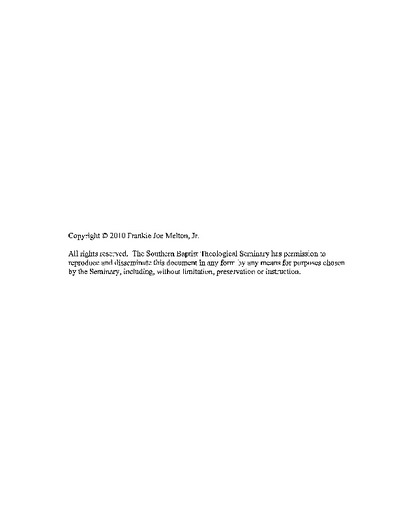A Rhetoriographical Analysis of Argumentum ad Baculum in the Published Sermons of George Whitefield
Abstract
This dissertation examines the use of argumentum ad baculum
in preaching in general and the sermons of George Whitefield in particular. Argumentum ad baculum
has traditionally been considered an informal fallacy of relevance. The fallacy can be
defined as an appeal to force or an appeal to fear. Chapter 1 discusses the relationship of
argumentum ad baculum with the empirical study of fear appeals and the rhetorical use of
pathos. Attention is also given to the preaching of Whitefield and his place in the history
of preaching as an innovator. Whitefield's role in the shift to a more passionate and
emotional sermon style is noted. The chapter also addresses the challenges a study of
Whitefield's sermons presents.
Chapter 2 is devoted to defining argumentum ad baculum, examining the
history of the phrase, the two ways it has been defined, the nature of it as a fallacy, and
fear appeals as a part of the definition. The chapter includes a discussion of source
credibility in relation to fear appeals.
Chapter 3 analyses the sermons of Whitefield to identify his use of fear
appeals. The types of fear appeals he used in his sermons are listed along with
evidentiary sermon material. The types of material Whitefield used to formulate the
appeals are also discussed.
Chapter 4 gives attention to the effect of Whitefield's fear appeals on his
auditors. In order for an appeal to be effective, it must first arouse fear in the recipients
of the appeal. Historical narratives are examined from Whitefield himself, eyewitness
accounts, and personal testimonies of those who were present at his meetings. The
chapter provides evidence of the general and specific effect of Whitefield's fear appeals.
Chapter 5 concerns the ethicality of Whitefield's appeals. The chapter surveys
a number of standards for ethical judgment. The chapter argues that Whitefield's use of
fear in his published sermons was ethical, primarily because of the intention with which
he used them.
Chapter 6 offers guidelines for the contemporary use of argumentum ad
baculum in preaching. Modern audiences are unaccustomed to the use of fear for
persuasive means. However, this type of argumentation can be used ethically and
effectively.

